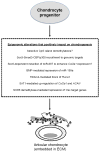Epigenomic and microRNA-mediated regulation in cartilage development, homeostasis, and osteoarthritis
- PMID: 22178468
- PMCID: PMC3282171
- DOI: 10.1016/j.molmed.2011.11.005
Epigenomic and microRNA-mediated regulation in cartilage development, homeostasis, and osteoarthritis
Abstract
Osteoarthritis (OA) is a multifactorial disease subject to the effects of many genes and environmental factors. Alterations in the normal pattern of chondrocyte gene control in cartilage facilitate the onset and progression of OA. Stable changes in patterns of gene expression, not associated with alterations in DNA sequences, occur through epigenetic changes, including DNA methylation, histone modifications, and alterations in chromatin structure, as well as by microRNA (miRNA)-mediated mechanisms. Moreover, the ability of the host to repair damaged cartilage is reflected in alterations in gene control circuits, suggestive of an epigenetic and miRNA-dependent tug-of-war between tissue homeostasis and OA disease pathogenesis. Herein, we summarize epigenetic and miRNA-mediated mechanisms impacting on OA progression and in this context offer potential therapeutic strategies for OA treatment.
Copyright © 2011 Elsevier Ltd. All rights reserved.
Figures



Similar articles
-
Epigenetics in osteoarthritis and its implication for future therapeutics.Expert Opin Biol Ther. 2013 May;13(5):713-21. doi: 10.1517/14712598.2013.764410. Epub 2013 Feb 15. Expert Opin Biol Ther. 2013. PMID: 23410522 Review.
-
Oxidative stress, autophagy, epigenetic changes and regulation by miRNAs as potential therapeutic targets in osteoarthritis.Biochem Pharmacol. 2016 May 15;108:1-10. doi: 10.1016/j.bcp.2015.12.012. Epub 2015 Dec 19. Biochem Pharmacol. 2016. PMID: 26711691 Review.
-
Do MicroRNAs have a key epigenetic role in osteoarthritis and in mechanotransduction?Clin Exp Rheumatol. 2017 May-Jun;35(3):518-526. Epub 2017 Jan 4. Clin Exp Rheumatol. 2017. PMID: 28079507 Review.
-
DNA methyltransferase 3 beta mediates the methylation of the microRNA-34a promoter and enhances chondrocyte viability in osteoarthritis.Bioengineered. 2021 Dec;12(2):11138-11155. doi: 10.1080/21655979.2021.2005308. Bioengineered. 2021. PMID: 34783292 Free PMC article.
-
Epigenetic mechanisms and non-coding RNAs in osteoarthritis.Curr Rheumatol Rep. 2013 Sep;15(9):353. doi: 10.1007/s11926-013-0353-z. Curr Rheumatol Rep. 2013. PMID: 23888362 Review.
Cited by
-
Mangiferin Relieves Lipopolysaccharide-Induced Injury by Up-Regulating miR-181a via Targeting PTEN in ATDC5 Cells.Front Pharmacol. 2020 Mar 5;11:137. doi: 10.3389/fphar.2020.00137. eCollection 2020. Front Pharmacol. 2020. PMID: 32210798 Free PMC article.
-
Recent progress in osteoarthritis research.J Am Acad Orthop Surg. 2014 Jul;22(7):467-8. doi: 10.5435/JAAOS-22-07-467. J Am Acad Orthop Surg. 2014. PMID: 24966254 Free PMC article. No abstract available.
-
Secreted α-Klotho maintains cartilage tissue homeostasis by repressing NOS2 and ZIP8-MMP13 catabolic axis.Aging (Albany NY). 2018 Jun 19;10(6):1442-1453. doi: 10.18632/aging.101481. Aging (Albany NY). 2018. PMID: 29920476 Free PMC article.
-
MMP13-targeted siRNA-loaded micelles for diagnosis and treatment of posttraumatic osteoarthritis.Bioact Mater. 2024 Apr 23;37:378-392. doi: 10.1016/j.bioactmat.2024.04.010. eCollection 2024 Jul. Bioact Mater. 2024. PMID: 38689658 Free PMC article.
-
MicroRNA Levels as Prognostic Markers for the Differentiation Potential of Human Mesenchymal Stromal Cell Donors.Stem Cells Dev. 2015 Aug 15;24(16):1946-55. doi: 10.1089/scd.2014.0534. Epub 2015 Jun 17. Stem Cells Dev. 2015. PMID: 25915705 Free PMC article.
References
-
- Little CB, Fosang AJ. Is cartilage matrix breakdown an appropriate therapeutic target in osteoarthritis--insights from studies of aggrecan and collagen proteolysis? Curr Drug Targets. 2010;11:561–575. - PubMed
-
- van den Berg WB. Osteoarthritis year 2010 in review: pathomechanisms. Osteoarthritis Cartilage. 2011;19:338–341. - PubMed
-
- Glasson SS, et al. Deletion of active ADAMTS5 prevents cartilage degradation in a murine model of osteoarthritis. Nature. 2005;434:644–648. - PubMed
-
- Stanton H, et al. ADAMTS5 is the major aggrecanase in mouse cartilage in vivo and in vitro. Nature. 2005;434:648–652. - PubMed
Publication types
MeSH terms
Substances
Grants and funding
LinkOut - more resources
Full Text Sources
Other Literature Sources
Medical

